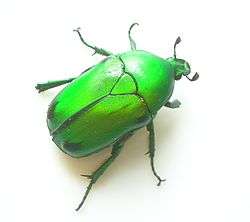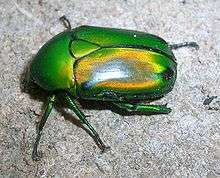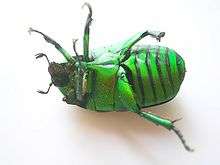Heterorrhina elegans
Heterorrhina elegans is a species of Scarab beetle found in India and Sri Lanka that belongs to the flower chafer subfamily. The adults are about 2 to 3 cm long and are usually bright glassy green appearing reddish at some angles. The clypeus is narrow and there is a ridge along the middle. They are seen in aggregations made up of large numbers in southern India during June to October.[2]
| Heterorrhina elegans | |
|---|---|
 | |
| Scientific classification | |
| Kingdom: | |
| Phylum: | |
| Class: | |
| Order: | |
| Family: | |
| Subfamily: | |
| Genus: | Heterorrhina |
| Species: | H. elegans |
| Binomial name | |
| Heterorrhina elegans (Fabricius, 1781) | |
| Synonyms | |
|
Cetonia elegans Fabricius, 1781[1] | |
Description

Adult beetles are emerald green with some varieties blue, red (var. fulgidissima), indigo, or black (var. anthracina). The sides of the hind coxae are orange. The elytra are glazed, with no deep pits on the surface and only tiny spots arranged in lines. The prothorax has punctures only along the sides and the scutellum is without any punctures. The antennae, legs, suture margins, posterior of the elytra and the apical calli are black. The clypeus may have some punctures and is squarish with parallel sides. The front margin is straight and toothed in the middle, the tooth is minutely notched. The forehead has lobed ridges running longitudinally. On the underside the sternal process is narrow and blunt, slightly curved. The middle and hind tibia are fringed with hairs in both the male and female. The hind tibiae bear a tuft of hairs near the tip with the males having longer hind tarsi than the females with the abdomen channelled beneath allowing them to mount females.[3]

The physics of the colouration of the cuticle is a subject of interest as the colours are entirely structural, not produced by pigments, and nearly 200-year-old specimens show no degradation of the colours.[4] The underlying structures made up of nearly 50 microscopic double layers[5] have been studied in the search for structural paints that do not need pigments which are often environmentally toxic chemicals.[6]
References
- Spec. Ins. I : 56 (text at biodiversitylibrary.org)
- Kumara,S; M. Sankar; V. Sethuramana; A. Musthak (2009). "Population dynamics of white grubs (Coleoptera: Scarabaeidae) in the rose environment of Northern Bangalore, India" (PDF). Indian Journal of Science and Technology. 2 (1): 46–52. Archived from the original (PDF) on 2011-07-26.
- Arrow, GJ (1910). The Fauna of British India. Coleoptera. Lamellicornia (Cetoniinae & Dynastinae). Taylor and Francis, London. pp. 93–94.
- Neville, AC; S Caveney (1969). "Scarabaeid beetle exocuticle as an optical analogue of cholesteric liquid crystals". Biological Reviews. 44 (4): 531–562. doi:10.1111/j.1469-185X.1969.tb00611.x. PMID 5308457.
- Steinbrecht RA; W. Mohren; H. K. Pulker; D. Schneider (1985). "Cuticular Interference Reflectors in the Golden Pupae of Danaine Butterflies". Proceedings of the Royal Society B. 226 (1244): 367–390. doi:10.1098/rspb.1985.0100.
- Lenau T; M. Barfoed (2008). "Colours and Metallic Sheen in Beetle Shells - A Biomimetic Search for Material Structuring Principles Causing Light Interference" (PDF). Advanced Engineering Materials. 10 (4): 299–314. doi:10.1002/adem.200700346.